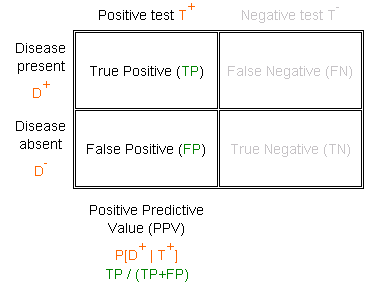
StATS: What is a positive predictive value?
The positive predictive value of a test is the probability that the patient has the disease when restricted to those patients who test positive. This term is sometimes abbreviated as PPV. You can compute the positive predictive value as
PPV = TP / (TP + FP)
where TP and FP are the number of true positive and false positive results, respectively. Notice that the denominator for positive predictive value is the number of patients who test positive. You can also define the positive predictive value using conditional probabilities,
PPV = P [ Patient has the disease | Test is positive ].
If the prevalence of the disease in your situation is different from the prevalence of the disease in the research study you are examining, then you can use likelihood ratios to estimate the PPV.
The following table summarizes these calculations.

Do not calculate the positive predictive value on a sample where the prevalence of the disease was artificially controlled. For example, the PPV is meaningless in a study where you artificially recruited healthy and diseased patients in a one to one ratio.
Here is an example.
This page was written by Steve Simon while working at Children's Mercy Hospital. Although I do not hold the copyright for this material, I am reproducing it here as a service, as it is no longer available on the Children's Mercy Hospital website. Need more information? I have a page with general help resources. You can also browse for pages similar to this one at Category: Definitions, Category: Diagnostic testing.